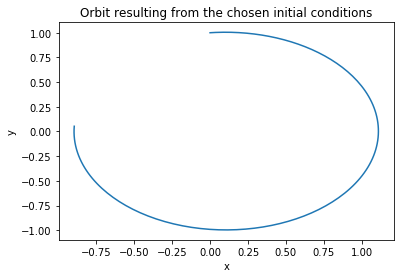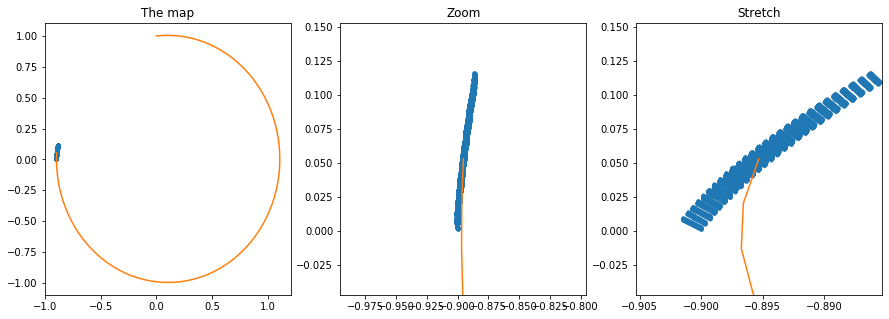4. High Order Taylor Maps I¶
(original by Dario Izzo - extended by Ekin Ozturk)
Building upon the notebook here, we show the use of desolver for numerically integrating the system of differential equations \(\dot{\mathbf y} = \mathbf f(\mathbf y)\):
which describe, in non dimensional units, the Keplerian motion of a mass point object around some primary body. We show how we can build a high order Taylor map (HOTM, indicated with \(\mathcal M\)) representing the final state of the system at the time \(T\) as a function of the initial conditions.
In other words, we build a polinomial representation of the relation \(\mathbf y(T) = \mathbf f(\mathbf y(0), T)\). Writing the initial conditions as \(\mathbf y(0) = \overline {\mathbf y}(0) + \mathbf {dy}\), our HOTM will be written as:
and will be valid in a neighbourhood of \(\overline {\mathbf y}(0)\).
4.1. Importing Stuff¶
[1]:
%matplotlib inline
from matplotlib import pyplot as plt
import os
import numpy as np
os.environ['DES_BACKEND'] = 'numpy'
import desolver as de
import desolver.backend as D
from desolver.backend import gdual_double as gdual
PyAudi backend is available.
Using numpy backend
[2]:
T = 1e-3
@de.rhs_prettifier(equ_repr="[vr, -1/r**2 + r*vt**2, vt, -2*vt*vr/r]", md_repr=r"""$$
\begin{array}{l}
\dot r = v_r \\
\dot v_r = - \frac 1{r^2} + r v_\theta^2\\
\dot \theta = v_\theta \\
\dot v_\theta = -2 \frac{v_\theta v_r}{r}
\end{array}
$$""")
def eom_kep_polar(t,y,**kwargs):
return D.array([y[1], - 1 / y[0] / y[0] + y[0] * y[3]*y[3], y[3], -2*y[3]*y[1]/y[0] - T])
eom_kep_polar
[2]:
[3]:
# The initial conditions
ic = [1.,0.1,0.,1.]
4.2. We perform the numerical integration using floats (the standard way)¶
[4]:
D.set_float_fmt('float64')
float_integration = de.OdeSystem(eom_kep_polar, y0=ic, dense_output=False, t=(0, 5.), dt=0.01, rtol=1e-12, atol=1e-12, constants=dict())
float_integration.set_method("RK45")
float_integration.integrate(eta=True)
[5]:
# Here we transform from polar to cartesian coordinates
# to then plot
y = float_integration.y
cx = [it[0]*np.sin(it[2]) for it in y.astype(np.float64)]
cy = [it[0]*np.cos(it[2]) for it in y.astype(np.float64)]
plt.plot(cx,cy)
plt.title("Orbit resulting from the chosen initial conditions")
plt.xlabel("x")
plt.ylabel("y")
[5]:
Text(0, 0.5, 'y')

4.3. We perform the numerical integration using gduals (to get a HOTM)¶
[6]:
# Order of the Taylor Map. If we have 4 variables the number of terms in the Taylor expansion in 329 at order 7
order = 5
# We now define the initial conditions as gdual (not float)
ic_g = [gdual(ic[0], "r", order), gdual(ic[1], "vr", order), gdual(ic[2], "t", order), gdual(ic[3], "vt", order)]
[7]:
import time
start_time = time.time()
D.set_float_fmt('gdual_double')
gdual_integration = de.OdeSystem(eom_kep_polar, y0=ic_g, dense_output=False, t=(0, 5.), dt=0.01, rtol=1e-12, atol=1e-12, constants=dict())
gdual_integration.set_method("RK45")
gdual_integration.integrate(eta=True)
print("--- %s seconds ---" % (time.time() - start_time))
--- 3.7148001194000244 seconds ---
[8]:
# We extract the last point
yf = gdual_integration.y[-1]
# And unpack it into some convinient names
rf,vrf,tf,vtf = yf
# We compute the final cartesian components
xf = rf * D.sin(tf)
yf = rf * D.cos(tf)
# Note that you can get the latex representation of the gdual
print(xf._repr_latex_())
print("xf (latex):")
xf
\[ 9.62324{dt}^{3}{dvt}^{2}-287.941{dt}^{2}{dvt}^{3}-339.246{dr}{dt}^{2}{dvr}^{2}-1163.38{dr}^{2}{dt}^{2}{dvr}-55841{dr}^{3}{dvr}-14155.1{dvt}^{4}+173.989{dvt}^{2}+45397.4{dr}^{4}{dt}-2.51218e+06{dr}^{2}{dvt}^{3}-36.4141{dt}^{2}{dvr}{dvt}+2655.96{dr}^{3}+8351.27{dr}{dt}{dvt}^{2}+134833{dr}^{3}{dt}{dvt}-4.31954e+06{dr}^{3}{dvt}^{2}-2.94774e+06{dr}^{2}{dvr}{dvt}^{2}-13.1439{dt}{dvr}^{2}+101890{dr}^{2}{dt}{dvr}{dvt}+22840.3{dr}{dt}{dvr}^{2}{dvt}+2550.6{dr}{dvr}{dvt}+5780.38{dr}^{2}{dvt}+346.756{dvr}^{2}{dvt}+1330.3{dt}{dvr}^{3}{dvt}-20.4879{dt}{dvt}+0.631304{dt}^{3}{dvr}-1710.37{dr}^{2}{dvr}^{2}-0.110791{dt}^{4}{dvt}-337.535{dr}{dt}^{2}{dvt}+762.507{dt}{dvr}{dvt}^{2}-64.2798{dr}{dt}{dvr}-25920.5{dvr}^{3}{dvt}^{2}+138.386{dvr}^{4}+0.633023{dvr}+83.5605{dt}{dvr}^{2}{dvt}+2892.65{dr}{dt}{dvr}{dvt}+72.8282{dvr}{dvt}-0.316512{dt}^{2}{dvr}+5.3273{dt}^{3}{dvr}{dvt}+46793.3{dr}{dt}{dvt}^{3}+141.812{dr}{dvr}+10.7133{dr}{dt}^{3}{dvr}-3.60855e+06{dr}^{3}{dvr}{dvt}-24.6985{dt}^{2}{dvr}^{3}-545726{dr}{dvr}^{2}{dvt}^{2}+1260.23{dr}{dvr}^{3}+2821.14{dr}^{2}{dt}{dvr}-95997.3{dvr}^{2}{dvt}^{3}+6018.59{dt}{dvt}^{4}-39.0601{dr}{dt}-0.219359{dr}{dt}^{4}-86.9944{dt}^{2}{dvt}^{2}+\ldots+\mathcal{O}\left(6\right) \]
xf (latex):
[8]:
[9]:
# We can extract the value of the polinomial when $\mathbf {dy} = 0$
print("Final x from the gdual integration", xf.constant_cf)
print("Final y from the gdual integration", yf.constant_cf)
# And check its indeed the result of the 'reference' trajectory (the lineariation point)
print("\nFinal x from the float integration", cx[-1])
print("Final y from the float integration", cy[-1])
Final x from the gdual integration -0.8953272292032805
Final y from the gdual integration 0.052709201662514145
Final x from the float integration -0.8953272292032807
Final y from the float integration 0.052709201662513354
4.4. We visualize the HOTM¶
[10]:
# Let us now visualize the Taylor map by creating a grid of perturbations on the initial conditions and
# evaluating the map for those values
Npoints = 10 # 10000 points
epsilon = 1e-3
grid = np.arange(-epsilon,epsilon,2*epsilon/Npoints)
nxf = [0] * len(grid)**4
nyf = [0] * len(grid)**4
i=0
import time
start_time = time.time()
for dr in grid:
for dt in grid:
for dvr in grid:
for dvt in grid:
nxf[i] = xf.evaluate({"dr":dr, "dt":dt, "dvr":dvr,"dvt":dvt})
nyf[i] = yf.evaluate({"dr":dr, "dt":dt, "dvr":dvr,"dvt":dvt})
i = i+1
print("--- %s seconds ---" % (time.time() - start_time))
--- 0.9997782707214355 seconds ---
[11]:
f, axarr = plt.subplots(1,3,figsize=(15,5))
# Normal plot of the final map
axarr[0].plot(nxf,nyf,'.')
axarr[0].plot(cx,cy)
axarr[0].set_title("The map")
# Zoomed plot of the final map (equal axis)
axarr[1].plot(nxf,nyf,'.')
axarr[1].plot(cx,cy)
axarr[1].set_xlim([cx[-1] - 0.1, cx[-1] + 0.1])
axarr[1].set_ylim([cy[-1] - 0.1, cy[-1] + 0.1])
axarr[1].set_title("Zoom")
# Zoomed plot of the final map (unequal axis)
axarr[2].plot(nxf,nyf,'.')
axarr[2].plot(cx,cy)
axarr[2].set_xlim([cx[-1] - 0.01, cx[-1] + 0.01])
axarr[2].set_ylim([cy[-1] - 0.1, cy[-1] + 0.1])
axarr[2].set_title("Stretch")
#axarr[1].set_xlim([cx[-1] - 0.1, cx[-1] + 0.1])
#axarr[1].set_ylim([cy[-1] - 0.1, cy[-1] + 0.1])
[11]:
Text(0.5, 1.0, 'Stretch')

4.5. How much faster is now to evaluate the Map rather than perform a new numerical integration?¶
[12]:
# First we profile the method evaluate (note that you need to call the method 4 times to get the full state)
[13]:
%timeit xf.evaluate({"dr":epsilon, "dt":epsilon, "dvr":epsilon,"dvt":epsilon})
50.3 µs ± 4.94 µs per loop (mean ± std. dev. of 7 runs, 10000 loops each)
[14]:
# Then we profile the Runge-Kutta 4 integrator
[15]:
%%timeit
D.set_float_fmt('float64')
float_integration = de.OdeSystem(eom_kep_polar, y0=[it + epsilon for it in ic], dense_output=False, t=(0, 5.), dt=0.01, rtol=1e-12, atol=1e-12, constants=dict())
float_integration.set_method("RK45")
float_integration.integrate(eta=False)
75.1 ms ± 7.15 ms per loop (mean ± std. dev. of 7 runs, 10 loops each)
[16]:
# It seems the speedup is 2-3 orders of magnitude, but did we loose precision?
# We plot the error in the final result as computed by the HOTM and by the Runge-Kutta
# as a function of the distance from the original initial conditions
out = []
pert = np.arange(0,0.1,1e-3)
for epsilon in pert:
res_map_xf = xf.evaluate({"dr":epsilon, "dt":epsilon, "dvr":epsilon,"dvt":epsilon})
res_int = de.OdeSystem(eom_kep_polar, y0=[it + epsilon for it in ic], dense_output=False, t=(0, 5.), dt=0.01, rtol=1e-12, atol=1e-12, constants=dict())
res_int.set_method("RK45")
res_int.integrate()
res_int_x = [it.y[0]*np.sin(it.y[2]) for it in res_int]
res_int_xf = res_int_x[-1]
out.append(np.abs(res_map_xf - res_int_xf))
plt.semilogy(pert,out)
plt.title("Error introduced by the use of the polynomial")
plt.xlabel("Perturbation of the initial conditions")
plt.ylabel("Error in estimating the final state (x)")
[16]:
Text(0, 0.5, 'Error in estimating the final state (x)')
